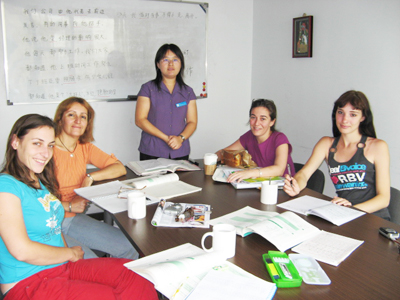
When I first arrived in Taiwan, one of my main goals while being here was to learn Chinese. In the beginning, I figured I would automatically learn the language just by being here. So I focused on learning street Chinese – the way locals spoke it!
After I began to get serious about learning Chinese in Taiwan, I started attending classes at local language centers. I ended up trying out three different ones to get a feel for the different styles.
I found clear benefits to learning Chinese in a classroom setting, as opposed to Over time, I tried to integrate as many of these benefits as I could into CLO.
Having a Live Teacher
As good as online courses can get, there is no replacement for having a live speaker to practice with. The teachers I had were very good. There was a lot of interaction and they challenged you to come up with new answers to questions, using the Chinese that was taught in class.
While most of CLO is designed to be self study, I did try to integrate some of the “live teacher” aspect into the exercises feature. The questions posted there are purposely open ended, like the ones you would hear in a classroom. Submit your own answer in your own format and a real teacher will send you feedback on your grammar and character choices (if your answer was typed) or your pronunciation (if your answer was an audio submission).
And of course, we also offer the option of live one on one classes via Skype, if you prefer.
Lots of Repetition
I actually got a shock the first day of class when the teacher came in and began speaking a mile a minute. I barely understood 20% of what she was saying. I worried that I was in the wrong class and should transfer to a lower level. Fortunately I persisted.
As the classes continued, I realized that 80% of what she was speaking was repeated from class to class. Things like “Hello class, how are you? How was your weekend? Ok, let’s turn to chapter 3 of your text book. Who wants to start reading?”
Over time I began to learn these phrases and expressions very quickly as they were repeated again and again in each class.
Once I figured out those phrases, there was only 20% of new material. This became a good source of comprehensible input, as I could now learn new material in the context of what I already knew. I found my brain much more in tune at this stage, whereas earlier it would start to tune out when there was too much new material.
I’ve tried to implement this same concept in the CLO course. Lessons from later levels are conducted almost entirely in Chinese, which could scare some away. But:
a) It’s all Chinese that was taught in earlier lessons.
b) Most of the phrases are repeated again and again in each lesson. Phrases like “Welcome to Learn Chinese Online, lesson X”, “Let’s listen to today’s dialog at normal speed”, “Let’s listen to the dialog again at a slower speed. Please repeat after her.”, “What does this word mean?”, “Do you remember what that means?” etc.
So once you get used to all these phrases (which you should, since you’re hearing them so often), the rest of the lesson should be a breeze, since it’s only 20% or less new material.
Learning from Other Students
While in class, other students would ask questions that I hadn’t thought of, that I would learn from. The teacher would also ask the same question to different students around the class, so while you were formulating your own answer to the question, you could also listen in and learn from what other students were responding with.
The Comments section in each lesson is meant to emulate this aspect. You can read what questions others have asked and learn from the answers given, or submit your own.
While I enjoyed the experience of learning Chinese in a classroom environment, there were also some areas that I wasn’t pleased about, that I felt could be improved. I’ll discuss these issues in the next post.
